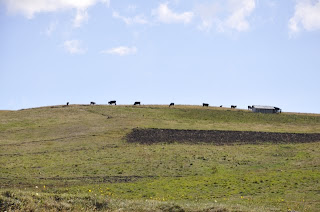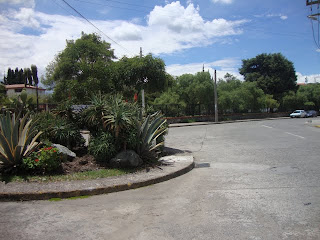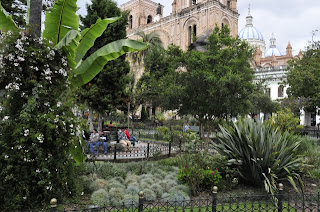We are basically a typical American family when it comes to privacy and are quite like most other North Americans who have an acutely defined sense of personal space. Possibly this sense of personal space can be better phrased as, “please keep your distance.” Though it is not terribly admirable, we are conscious of how close we stand to another person, our body language, how we present ourselves in public, eye contact, and a host of other rather puritanical behaviors that date back to our childhood educations. Though this zone of protection is not unique in the world, it is certainly honed to perfection in the US. One of the early shocks a North American gets when arriving in a Latin country like Ecuador is the almost complete loss of personal privacy or space. This posting is in no way a criticism only an observation of Latin behavior that is often subtle and at other times absolutely blatant. Some of the challenges to a North American’s sense of personal space are easy to accept. Others will take a little time.
Kissing strangers – One of the nicest customs in Ecuador is the way men and women kiss each other on the cheek when they are introduced and on greeting each other whenever they meet again. We have even seen some men, often family members, who will buss each other on the cheek on greeting. Children, and even more amazingly, teenagers will give you a welcoming kiss on the cheek. This seems so much nicer than the cold, very formal handshake.
Public display of affection – you will often see young men and women embracing on a street corner or leaning up against a wall locked in a kiss, with no concern about who might be watching. In the parks, you might find an older couple laying on the grass, unselfconsciously huddled next to each other, the man asleep and his wife shading his face with her arm or a magazine. Elderly couples often walk holding hands. Women walking together will almost always stroll by arm in arm. It is a sense of public affection North Americans are not used to.
Erotic advertising – much of the TV, newspaper, and magazine advertising is like that in Europe with considerable nudity and erotic posing and not subject to the censorship imposed in the US.
Dressing – Except for lawyers, doctors and some officials and business men, the dress code for those of us in Cuenca is quite casual. We rarely “dress up” when we go out for dinner even in the finest restaurants. However, most men are well attired. Only a few wear sneakers or non-collared shirts. Women rarely wear dresses and most of the time wear tight jeans or slacks, high heels and are much less puritanical about cleavage than the average American. Unconcerned by body size or age, Cuenca women appear to make a great effort to look stylish.
Staring – It takes quite a while to get used to the way Ecuadorians stare directly at you and often do not look away when you look back at them. Whether it is because of most gringos’ Caucasian appearance or our way of dressing, people tend to make long staring observations of us.
Picking up a child – An Ecuadorian would never ask if it is all right to reach down and pick up your child. It would not dawn on them that the child might be afraid of a stranger or has been told to be cautious with a person they do not know. Ecuadorian children are usually very shy and absolutely obedient to their parents and teachers. Ecuadorians therefore don’t even think that the child might be concerned or afraid.
Strangers reading your document – if you are standing in line reading something, people nearby will lean over to try to see what you are reading. If you frown at them for reading your document, you most often get a look of complete misunderstanding of why you are frowning.
ATM’s – There is no yellow line 15 feet back from the ATM machine like in the US. While you stand in front of the machine taking out your money, the next person in line will often stand only a few feet behind you.
Standing in line – On many occasions, when you are standing in line at the bank or any other crowded place, people will push and try to get in front of you. As a contradiction, older people are supposed to be allowed to go to the front of the line without waiting.
Neatness – Most Ecuadorians are meticulous in their personal cleanliness. Workers always change from street clothes into work clothes when arriving on the job and wash their hands and faces, wet down their hair, and change back to street clothes before they leave. It is a rarity to see a disheveled person and we have yet to run into someone who “smells bad.”
Public Urination – It is always a surprise to see a man relieving himself on the street against a wall, a store front, or a tree. No one seems to notice or care.
Rude driving behavior - Cutting you off, passing on wrong side, honking as the traffic light turns yellow, racing to get ahead of you, are all symptomatic of the Ecuadorian driver’s ethic. It is road rage at its zenith but there is no rage. If you give them a dirty look for some infraction of what you might call proper driving behavior, you get a surprised look in response. “What did I do wrong?” is the facial expression.
Security – A touchy subject that we all don’t agree on. Personal security on the street is quite important and everyone should follow the proven advice of staying alert to potential thieves, not wearing expensive looking jewelry, holding purses close to your body, and not carrying camera’s or cell phones where they can be easily snatched. In a poor country like Ecuador, these items represent enormous wealth to some. Whatever the financial status of our gringo friends, just the fact that they are gringos sends out the message that they are rich and will be carrying expensive items. This is personal space that we too often take for granted as secure.
+Bill+and+Loretta.bmp)








+start.bmp)



+restaurant+view.bmp)





























